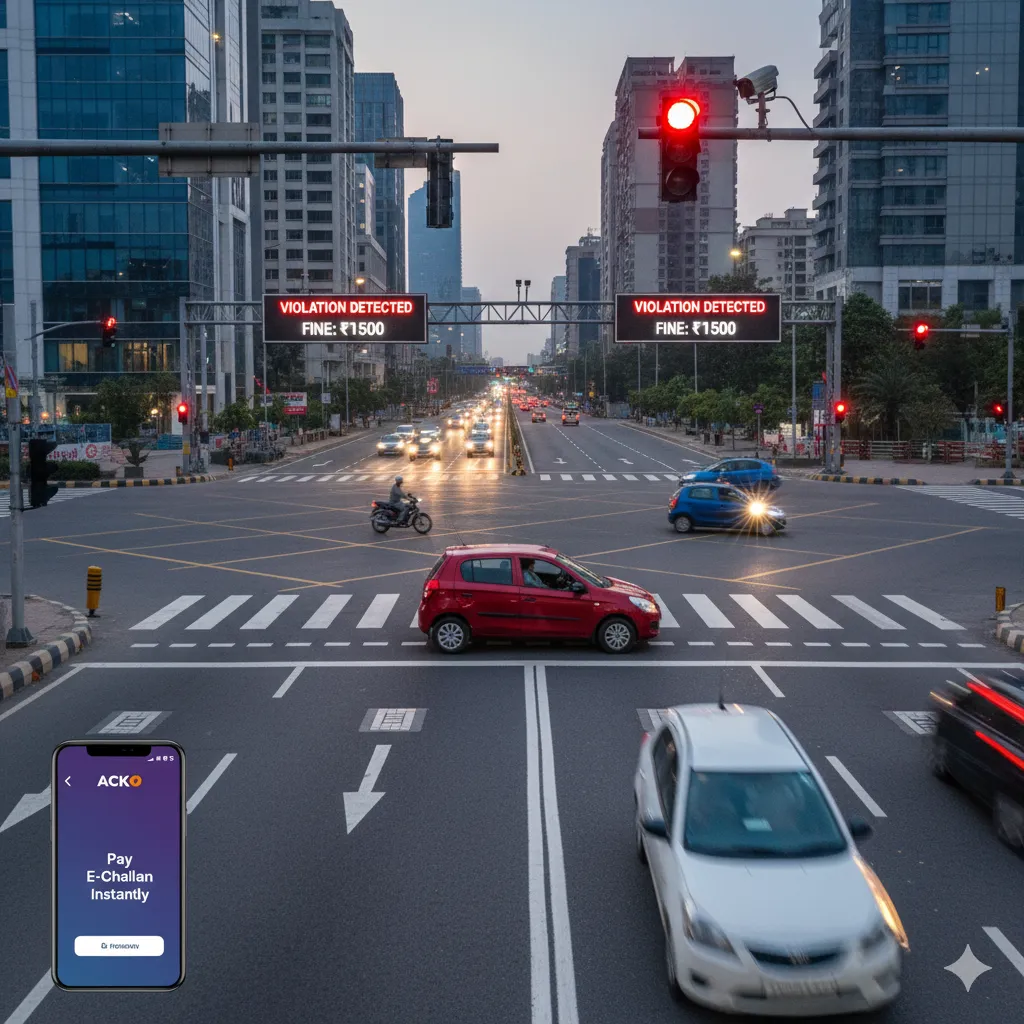Home / Motor Insurance / Articles / Traffic Rules / Stop Line vs. Signal Jump: Understanding the Fine Difference and Enforcement Technology
Stop Line vs. Signal Jump: Understanding the Fine Difference and Enforcement Technology
Saumya SrivastavaNov 18, 2025
Share Post
A red light generally does more than just halt traffic on the road; it quickly tests the patience and awareness of drivers. One wrong move and the driver could end up paying a signal jump fine, or an echallan for a stop-sign violation.
A signal jump occurs when a driver proceeds through a red light, while a stop-line violation occurs when a vehicle crosses the solid white line before the pedestrian crossing. Both are common offences in India, but each carries its own implications for road safety and penalties.
So, let us keep reading to clearly understand the difference between a stop line violation challan and a signal jump fine challan.

Contents
Difference Between a Stop Line and a Signal Jump Violation
Feature | Stop Line Violation | Signal Jump Violation |
|---|---|---|
Meaning | A stop line violation occurs when a driver crosses a solid white line before a pedestrian crossing or a traffic signal. | A signal jump occurs when a driver violates traffic regulations by failing to halt at a traffic light. |
Common Cause | Lack of patience while stopping at the crossing | Distracted driving or deliberate action |
Why It Matters | It puts pedestrians waiting to cross in danger | It is one of the most significant causes of road accidents |
Severity | Minor | Major |
Detection | Use of stop line cameras, induction loops | Use of red light or intersection cameras, induction loops, and on-site traffic police |
Penalty | Lower, and the traffic police give a fair warning. Fine: ₹500 and above, depending on the state | Higher, with potential court summons. Fine: ₹1000 and above, could even lead to license suspension. |
How do the Traffic Fines Apply in a Stop Line and Signal Jump Violation?
The traffic fines for stop line violations and signal jumping vary from one state to another. For example, for a stop line violation in Kolkata, under Rule 7 MV (Driving) Regulation, an offender pays ₹500 for the first offence and ₹1500 for the subsequent offence.
Similarly, for a signal jump fine in Kolkata, under Rule 12 of the MV(Driving) Regulations, an offender pays ₹500 for the first offence and ₹1500 for subsequent offences.
How Technology Enforcement Detects a Stop Line or Red Light Jumping Penalty
The 2019 Motor Vehicles Act introduced enforcement technology for traffic rules, including CCTV, body-worn cameras, ANPR, induction loops, and speed guns, with the goal of reducing road fatalities by 50% by 2030. These tools accurately detect stop-line and signal-jump violations in states across India and help them issue fines digitally through systems like echallan up.
Here is how the enforcement of technology for traffic rules helps to detect a stop line or signal jump violation:
1. Electronic Monitoring
Under the Smart Cities Mission, over 83,000 CCTVs have been installed in 100 smart cities, with both Intelligent Transport Management Systems (ITMS) and Integrated Command and Control Centres (ICCCs) implemented. These contribute not only to traffic management but also to crime prevention through monitoring the traffic ecosystem.
2. Induction Loop
Induction loops have been embedded in pavements for decades, helping detect a stop line or a signal jump violation. They sense a change in their magnetic field when a vehicle passes, which generates an electrical signal.
As a consequence, an electrical unit instantly catches the corresponding shift in the loop’s circuit. Now, radar-based non-intrusive, software-defined sensors are used.
The Bottom Line
Many drivers pay fines for signal jumping or stop-line violations without fully understanding the difference between the two. Understanding the difference between a stop-line violation and a signal jump is crucial for every driver. While both attract fines, their implications for road safety differ. With the government’s focus on advanced traffic enforcement technologies, compliance with traffic rules is becoming more transparent and efficient.
Want to check and pay your traffic challans easily? Download the ACKO app today to view and pay all your e-challans instantly using your preferred payment method.
Frequently Asked Questions
What is the signal jumping fine in India?
According to the Motor Vehicle Amendment Act of 2019, the standard signal jumping fine in India is ₹1000 for the first offence. However, the fine can vary from one state to another or when there are repeated violations.
Can I get my traffic fines reduced after signal jumping?
No, in India, you cannot reduce your traffic fines for signal jumping, as the Motor Vehicles Act sets the penalties. However, you can contest the challan if you feel the fine is wrongly imposed. You can also plead for leniency in court, where you have to show a genuine reason for the traffic violation.
Is it better to pay a fine or go to court for a stop line violation?
Paying the fine on time within 60 days of challan issuance is always better than going to court. It is a much simpler and straightforward process compared to going to court, since when you go to court, you must have a strong reason to convince the court that the traffic violation ticket was issued to you mistakenly.

Recent
Articles
How to Pay Traffic Challan Via Net Banking?
Saumya Srivastava Nov 18, 2025
Challans for Improper Vehicle Lighting in India
Saumya Srivastava Nov 18, 2025
Stop Line vs. Signal Jump: Understanding the Fine Difference and Enforcement Technology
Saumya Srivastava Nov 18, 2025
Court Challan vs. E-Challan: The Difference
Saumya Srivastava Nov 12, 2025
10 Uncommon Traffic Violations That Can Cost You ₹10,000 or More
Saumya Srivastava Nov 12, 2025
All Articles
Want to post any comments?
Check Traffic Challans Instantly ⚡️
Enter your vehicle number
Check your challans


